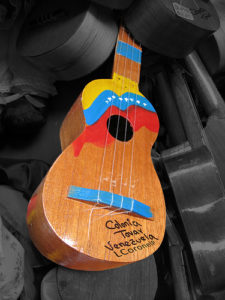Venezuela: Learning to Play the Cuatro on the Web 2.0
Laura Vidal

Image of a cuatro by Flickr user LCoronelP (CC BY-NC-ND 2.0)
The cuatro is the principal icon of traditional Venezuelan music. It is often learned at an early age and accompanies the majority of songs that recount the country’s folklore. The cuatro is present in almost all forms of musical expression, from the coastal drums to the calypso music of the south. Traditional choirs are often joined by a cuatro, and cantors also base their songs on the instrument. A love for the cuatro has also reached citizen media: songs of the joropo and gaita styles of music are shared here, and its history, musicians and even how to play the instrument, are widely discussed.
The blog Recreateoficial [es] relates part of its history
“It has very remote origins. Similar instruments appear in recordings from Iran and Crete in ovoid and square shapes (…) The four-stringed Arab lute or thimphle arrived in Spain at the start of the 16th century via the Moorish invasions. Here a new, less oval form was adapted, more similar to the current form of the “eight-stringed guitar” (…) The lute made its way to the Canary Islands, until it transformed into the timple. The timple would be exported to America and the Caribbean with the American Conquest, making many years later for the versions known today throughout South America. The Puerto Rican cuatro, however, maintains a closer resemblance to its ancestor, the lute, than the Canaries’ timple.”
The blogs micuatro.com [es] and tucuatro.com [es] share chords and songs through scores, adaptations and examples.
YouTube has a place for fans as well, thanks to video accounts from those like CuatroCriollo [es], who posts classes that make introductory courses easy:










